Investigating Type 2 Diabetes Among South Asians in the UK
VerifiedAdded on 2020/01/15
|11
|2889
|139
Report
AI Summary
This report investigates the elevated incidence of type 2 diabetes within the South Asian community residing in the United Kingdom. The research employs a secondary research methodology, analyzing existing literature and data to identify key contributing factors. The report delves into the background and rationale, highlighting the disproportionate impact of type 2 diabetes on this demographic, referencing census data and studies indicating increased risk due to factors like overweight and waist circumference. The study aims to pinpoint the primary causes and risk factors, while also assessing the potential of preventative measures. The methodology includes an in-depth literature review, utilizing search engines and academic databases such as Google Scholar, PubMed, Science Direct, and Emerald Insight. Exclusion and inclusion criteria are defined, focusing on English-language publications within a specific timeframe. The report also addresses ethical considerations and outlines the project structure, including chapter breakdowns covering introduction, literature review of causes (culture, lifestyle, genetics, and preventive measures), evaluation of public health policies, and a conclusion with recommendations. A project timetable, including a Gantt chart, details the research process. The study emphasizes the role of lifestyle choices, cultural influences, and genetic predispositions in the development of type 2 diabetes and explores potential interventions to mitigate the health crisis within this community.
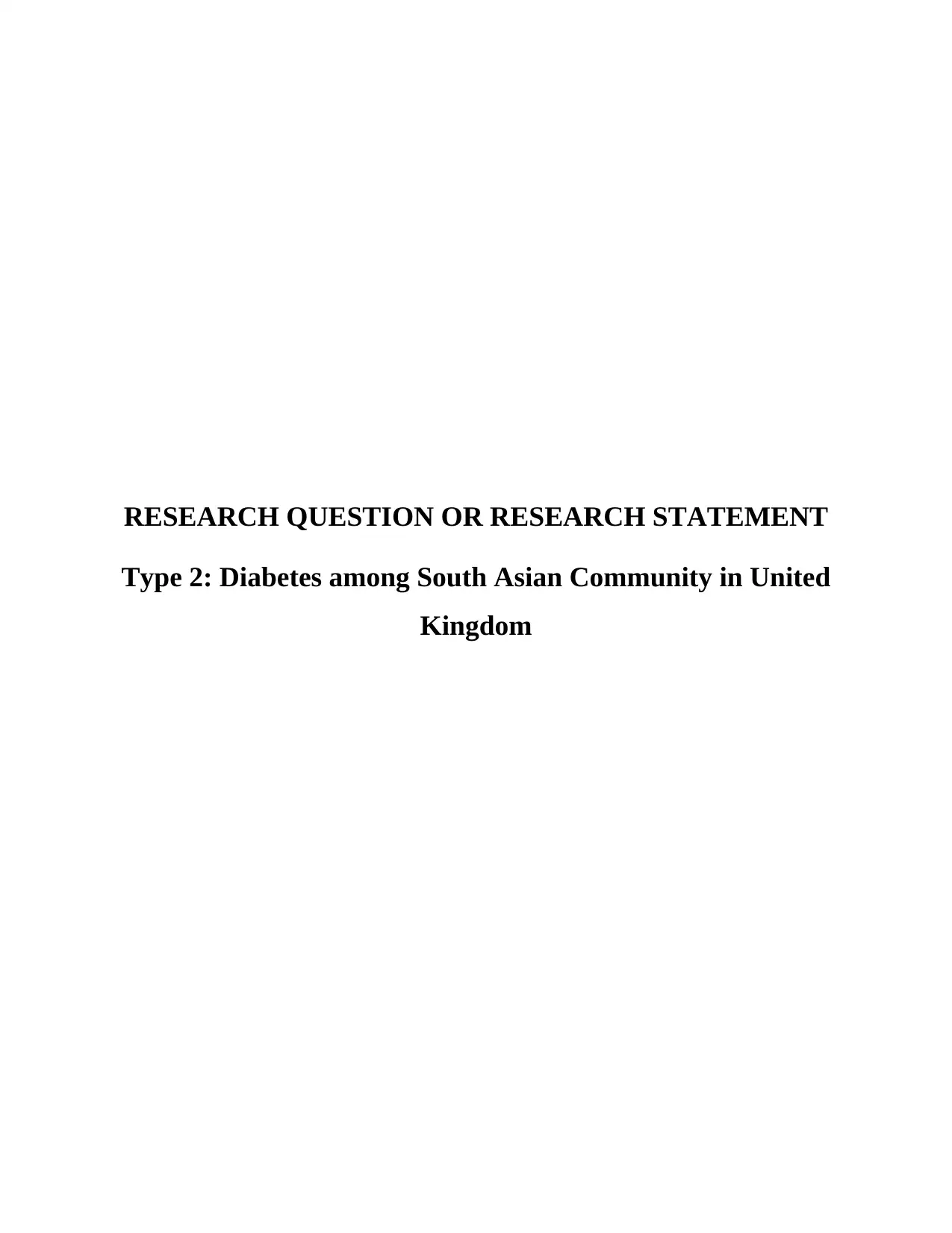
RESEARCH QUESTION OR RESEARCH STATEMENT
Type 2: Diabetes among South Asian Community in United
Kingdom
Type 2: Diabetes among South Asian Community in United
Kingdom
Paraphrase This Document
Need a fresh take? Get an instant paraphrase of this document with our AI Paraphraser
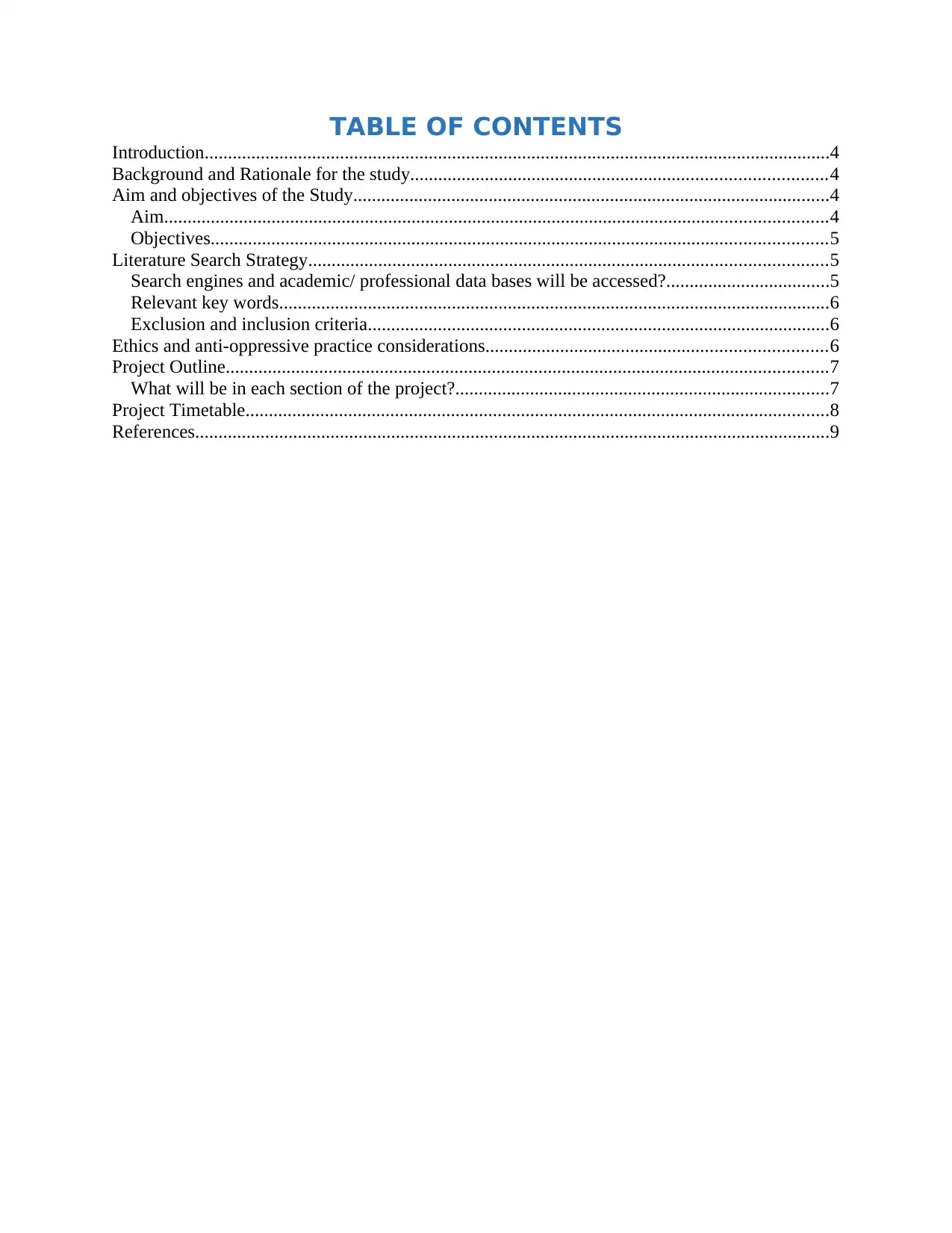
TABLE OF CONTENTS
Introduction......................................................................................................................................4
Background and Rationale for the study.........................................................................................4
Aim and objectives of the Study......................................................................................................4
Aim..............................................................................................................................................4
Objectives....................................................................................................................................5
Literature Search Strategy...............................................................................................................5
Search engines and academic/ professional data bases will be accessed?...................................5
Relevant key words......................................................................................................................6
Exclusion and inclusion criteria...................................................................................................6
Ethics and anti-oppressive practice considerations.........................................................................6
Project Outline.................................................................................................................................7
What will be in each section of the project?................................................................................7
Project Timetable.............................................................................................................................8
References........................................................................................................................................9
Introduction......................................................................................................................................4
Background and Rationale for the study.........................................................................................4
Aim and objectives of the Study......................................................................................................4
Aim..............................................................................................................................................4
Objectives....................................................................................................................................5
Literature Search Strategy...............................................................................................................5
Search engines and academic/ professional data bases will be accessed?...................................5
Relevant key words......................................................................................................................6
Exclusion and inclusion criteria...................................................................................................6
Ethics and anti-oppressive practice considerations.........................................................................6
Project Outline.................................................................................................................................7
What will be in each section of the project?................................................................................7
Project Timetable.............................................................................................................................8
References........................................................................................................................................9

LIST OF TABLES:
Table 1: Database structure.............................................................................................................5
Table 2: Key Words.........................................................................................................................6
Table 3: Gantt chart for project time scale......................................................................................8
Table 1: Database structure.............................................................................................................5
Table 2: Key Words.........................................................................................................................6
Table 3: Gantt chart for project time scale......................................................................................8
⊘ This is a preview!⊘
Do you want full access?
Subscribe today to unlock all pages.

Trusted by 1+ million students worldwide
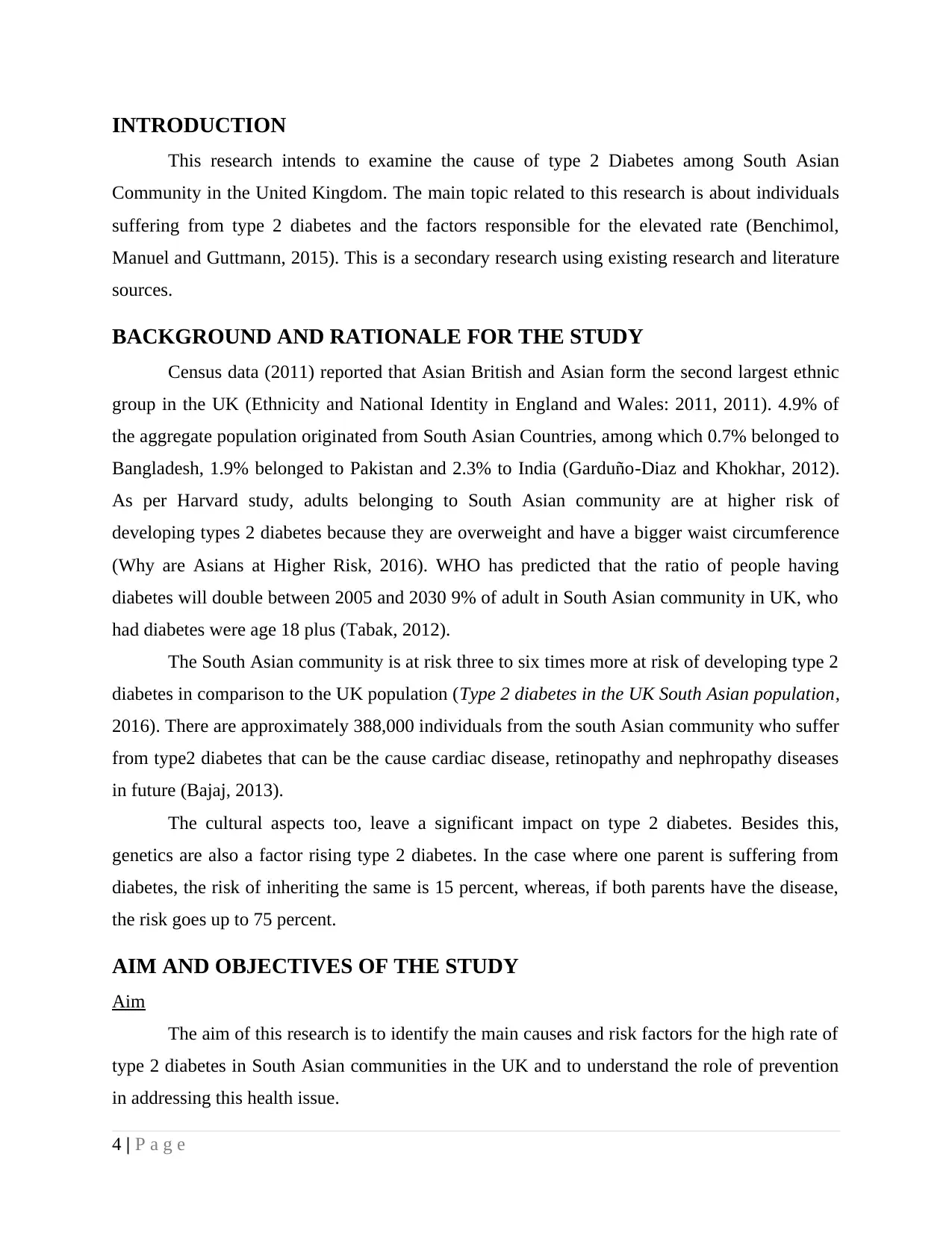
INTRODUCTION
This research intends to examine the cause of type 2 Diabetes among South Asian
Community in the United Kingdom. The main topic related to this research is about individuals
suffering from type 2 diabetes and the factors responsible for the elevated rate (Benchimol,
Manuel and Guttmann, 2015). This is a secondary research using existing research and literature
sources.
BACKGROUND AND RATIONALE FOR THE STUDY
Census data (2011) reported that Asian British and Asian form the second largest ethnic
group in the UK (Ethnicity and National Identity in England and Wales: 2011, 2011). 4.9% of
the aggregate population originated from South Asian Countries, among which 0.7% belonged to
Bangladesh, 1.9% belonged to Pakistan and 2.3% to India (Garduño‐Diaz and Khokhar, 2012).
As per Harvard study, adults belonging to South Asian community are at higher risk of
developing types 2 diabetes because they are overweight and have a bigger waist circumference
(Why are Asians at Higher Risk, 2016). WHO has predicted that the ratio of people having
diabetes will double between 2005 and 2030 9% of adult in South Asian community in UK, who
had diabetes were age 18 plus (Tabak, 2012).
The South Asian community is at risk three to six times more at risk of developing type 2
diabetes in comparison to the UK population (Type 2 diabetes in the UK South Asian population,
2016). There are approximately 388,000 individuals from the south Asian community who suffer
from type2 diabetes that can be the cause cardiac disease, retinopathy and nephropathy diseases
in future (Bajaj, 2013).
The cultural aspects too, leave a significant impact on type 2 diabetes. Besides this,
genetics are also a factor rising type 2 diabetes. In the case where one parent is suffering from
diabetes, the risk of inheriting the same is 15 percent, whereas, if both parents have the disease,
the risk goes up to 75 percent.
AIM AND OBJECTIVES OF THE STUDY
Aim
The aim of this research is to identify the main causes and risk factors for the high rate of
type 2 diabetes in South Asian communities in the UK and to understand the role of prevention
in addressing this health issue.
4 | P a g e
This research intends to examine the cause of type 2 Diabetes among South Asian
Community in the United Kingdom. The main topic related to this research is about individuals
suffering from type 2 diabetes and the factors responsible for the elevated rate (Benchimol,
Manuel and Guttmann, 2015). This is a secondary research using existing research and literature
sources.
BACKGROUND AND RATIONALE FOR THE STUDY
Census data (2011) reported that Asian British and Asian form the second largest ethnic
group in the UK (Ethnicity and National Identity in England and Wales: 2011, 2011). 4.9% of
the aggregate population originated from South Asian Countries, among which 0.7% belonged to
Bangladesh, 1.9% belonged to Pakistan and 2.3% to India (Garduño‐Diaz and Khokhar, 2012).
As per Harvard study, adults belonging to South Asian community are at higher risk of
developing types 2 diabetes because they are overweight and have a bigger waist circumference
(Why are Asians at Higher Risk, 2016). WHO has predicted that the ratio of people having
diabetes will double between 2005 and 2030 9% of adult in South Asian community in UK, who
had diabetes were age 18 plus (Tabak, 2012).
The South Asian community is at risk three to six times more at risk of developing type 2
diabetes in comparison to the UK population (Type 2 diabetes in the UK South Asian population,
2016). There are approximately 388,000 individuals from the south Asian community who suffer
from type2 diabetes that can be the cause cardiac disease, retinopathy and nephropathy diseases
in future (Bajaj, 2013).
The cultural aspects too, leave a significant impact on type 2 diabetes. Besides this,
genetics are also a factor rising type 2 diabetes. In the case where one parent is suffering from
diabetes, the risk of inheriting the same is 15 percent, whereas, if both parents have the disease,
the risk goes up to 75 percent.
AIM AND OBJECTIVES OF THE STUDY
Aim
The aim of this research is to identify the main causes and risk factors for the high rate of
type 2 diabetes in South Asian communities in the UK and to understand the role of prevention
in addressing this health issue.
4 | P a g e
Paraphrase This Document
Need a fresh take? Get an instant paraphrase of this document with our AI Paraphraser
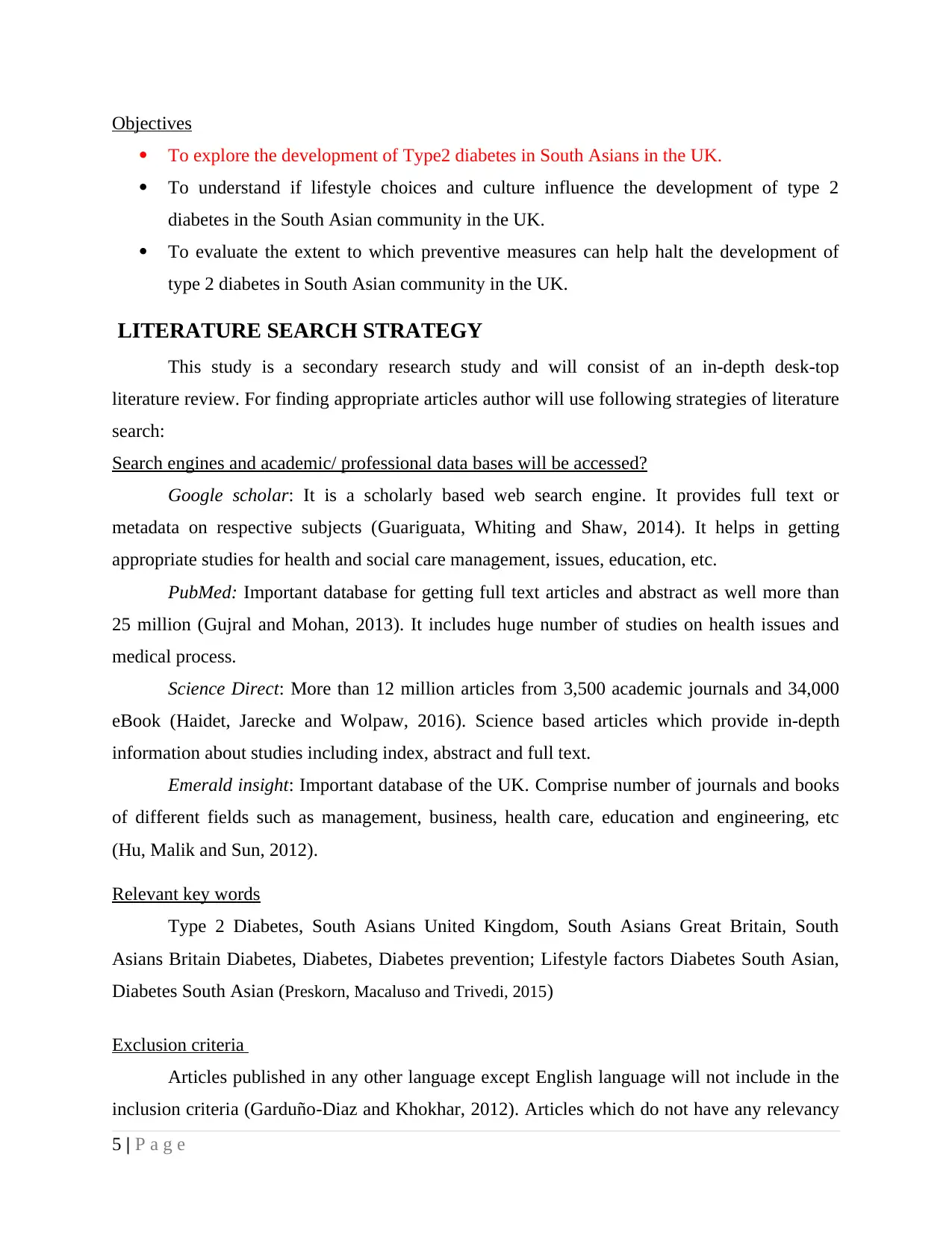
Objectives
To explore the development of Type2 diabetes in South Asians in the UK.
To understand if lifestyle choices and culture influence the development of type 2
diabetes in the South Asian community in the UK.
To evaluate the extent to which preventive measures can help halt the development of
type 2 diabetes in South Asian community in the UK.
LITERATURE SEARCH STRATEGY
This study is a secondary research study and will consist of an in-depth desk-top
literature review. For finding appropriate articles author will use following strategies of literature
search:
Search engines and academic/ professional data bases will be accessed?
Google scholar: It is a scholarly based web search engine. It provides full text or
metadata on respective subjects (Guariguata, Whiting and Shaw, 2014). It helps in getting
appropriate studies for health and social care management, issues, education, etc.
PubMed: Important database for getting full text articles and abstract as well more than
25 million (Gujral and Mohan, 2013). It includes huge number of studies on health issues and
medical process.
Science Direct: More than 12 million articles from 3,500 academic journals and 34,000
eBook (Haidet, Jarecke and Wolpaw, 2016). Science based articles which provide in-depth
information about studies including index, abstract and full text.
Emerald insight: Important database of the UK. Comprise number of journals and books
of different fields such as management, business, health care, education and engineering, etc
(Hu, Malik and Sun, 2012).
Relevant key words
Type 2 Diabetes, South Asians United Kingdom, South Asians Great Britain, South
Asians Britain Diabetes, Diabetes, Diabetes prevention; Lifestyle factors Diabetes South Asian,
Diabetes South Asian (Preskorn, Macaluso and Trivedi, 2015)
Exclusion criteria
Articles published in any other language except English language will not include in the
inclusion criteria (Garduño‐Diaz and Khokhar, 2012). Articles which do not have any relevancy
5 | P a g e
To explore the development of Type2 diabetes in South Asians in the UK.
To understand if lifestyle choices and culture influence the development of type 2
diabetes in the South Asian community in the UK.
To evaluate the extent to which preventive measures can help halt the development of
type 2 diabetes in South Asian community in the UK.
LITERATURE SEARCH STRATEGY
This study is a secondary research study and will consist of an in-depth desk-top
literature review. For finding appropriate articles author will use following strategies of literature
search:
Search engines and academic/ professional data bases will be accessed?
Google scholar: It is a scholarly based web search engine. It provides full text or
metadata on respective subjects (Guariguata, Whiting and Shaw, 2014). It helps in getting
appropriate studies for health and social care management, issues, education, etc.
PubMed: Important database for getting full text articles and abstract as well more than
25 million (Gujral and Mohan, 2013). It includes huge number of studies on health issues and
medical process.
Science Direct: More than 12 million articles from 3,500 academic journals and 34,000
eBook (Haidet, Jarecke and Wolpaw, 2016). Science based articles which provide in-depth
information about studies including index, abstract and full text.
Emerald insight: Important database of the UK. Comprise number of journals and books
of different fields such as management, business, health care, education and engineering, etc
(Hu, Malik and Sun, 2012).
Relevant key words
Type 2 Diabetes, South Asians United Kingdom, South Asians Great Britain, South
Asians Britain Diabetes, Diabetes, Diabetes prevention; Lifestyle factors Diabetes South Asian,
Diabetes South Asian (Preskorn, Macaluso and Trivedi, 2015)
Exclusion criteria
Articles published in any other language except English language will not include in the
inclusion criteria (Garduño‐Diaz and Khokhar, 2012). Articles which do not have any relevancy
5 | P a g e
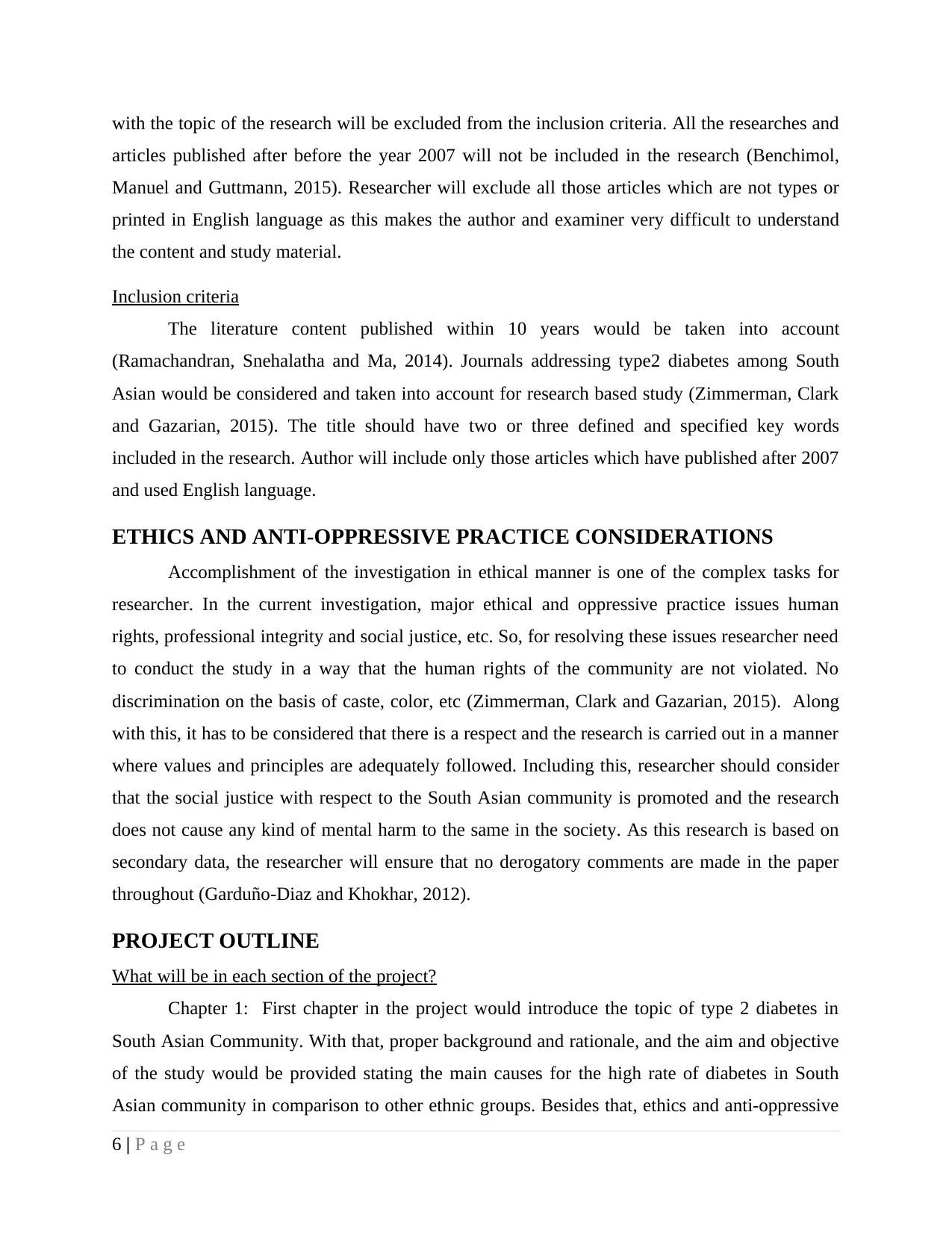
with the topic of the research will be excluded from the inclusion criteria. All the researches and
articles published after before the year 2007 will not be included in the research (Benchimol,
Manuel and Guttmann, 2015). Researcher will exclude all those articles which are not types or
printed in English language as this makes the author and examiner very difficult to understand
the content and study material.
Inclusion criteria
The literature content published within 10 years would be taken into account
(Ramachandran, Snehalatha and Ma, 2014). Journals addressing type2 diabetes among South
Asian would be considered and taken into account for research based study (Zimmerman, Clark
and Gazarian, 2015). The title should have two or three defined and specified key words
included in the research. Author will include only those articles which have published after 2007
and used English language.
ETHICS AND ANTI-OPPRESSIVE PRACTICE CONSIDERATIONS
Accomplishment of the investigation in ethical manner is one of the complex tasks for
researcher. In the current investigation, major ethical and oppressive practice issues human
rights, professional integrity and social justice, etc. So, for resolving these issues researcher need
to conduct the study in a way that the human rights of the community are not violated. No
discrimination on the basis of caste, color, etc (Zimmerman, Clark and Gazarian, 2015). Along
with this, it has to be considered that there is a respect and the research is carried out in a manner
where values and principles are adequately followed. Including this, researcher should consider
that the social justice with respect to the South Asian community is promoted and the research
does not cause any kind of mental harm to the same in the society. As this research is based on
secondary data, the researcher will ensure that no derogatory comments are made in the paper
throughout (Garduño‐Diaz and Khokhar, 2012).
PROJECT OUTLINE
What will be in each section of the project?
Chapter 1: First chapter in the project would introduce the topic of type 2 diabetes in
South Asian Community. With that, proper background and rationale, and the aim and objective
of the study would be provided stating the main causes for the high rate of diabetes in South
Asian community in comparison to other ethnic groups. Besides that, ethics and anti-oppressive
6 | P a g e
articles published after before the year 2007 will not be included in the research (Benchimol,
Manuel and Guttmann, 2015). Researcher will exclude all those articles which are not types or
printed in English language as this makes the author and examiner very difficult to understand
the content and study material.
Inclusion criteria
The literature content published within 10 years would be taken into account
(Ramachandran, Snehalatha and Ma, 2014). Journals addressing type2 diabetes among South
Asian would be considered and taken into account for research based study (Zimmerman, Clark
and Gazarian, 2015). The title should have two or three defined and specified key words
included in the research. Author will include only those articles which have published after 2007
and used English language.
ETHICS AND ANTI-OPPRESSIVE PRACTICE CONSIDERATIONS
Accomplishment of the investigation in ethical manner is one of the complex tasks for
researcher. In the current investigation, major ethical and oppressive practice issues human
rights, professional integrity and social justice, etc. So, for resolving these issues researcher need
to conduct the study in a way that the human rights of the community are not violated. No
discrimination on the basis of caste, color, etc (Zimmerman, Clark and Gazarian, 2015). Along
with this, it has to be considered that there is a respect and the research is carried out in a manner
where values and principles are adequately followed. Including this, researcher should consider
that the social justice with respect to the South Asian community is promoted and the research
does not cause any kind of mental harm to the same in the society. As this research is based on
secondary data, the researcher will ensure that no derogatory comments are made in the paper
throughout (Garduño‐Diaz and Khokhar, 2012).
PROJECT OUTLINE
What will be in each section of the project?
Chapter 1: First chapter in the project would introduce the topic of type 2 diabetes in
South Asian Community. With that, proper background and rationale, and the aim and objective
of the study would be provided stating the main causes for the high rate of diabetes in South
Asian community in comparison to other ethnic groups. Besides that, ethics and anti-oppressive
6 | P a g e
⊘ This is a preview!⊘
Do you want full access?
Subscribe today to unlock all pages.

Trusted by 1+ million students worldwide
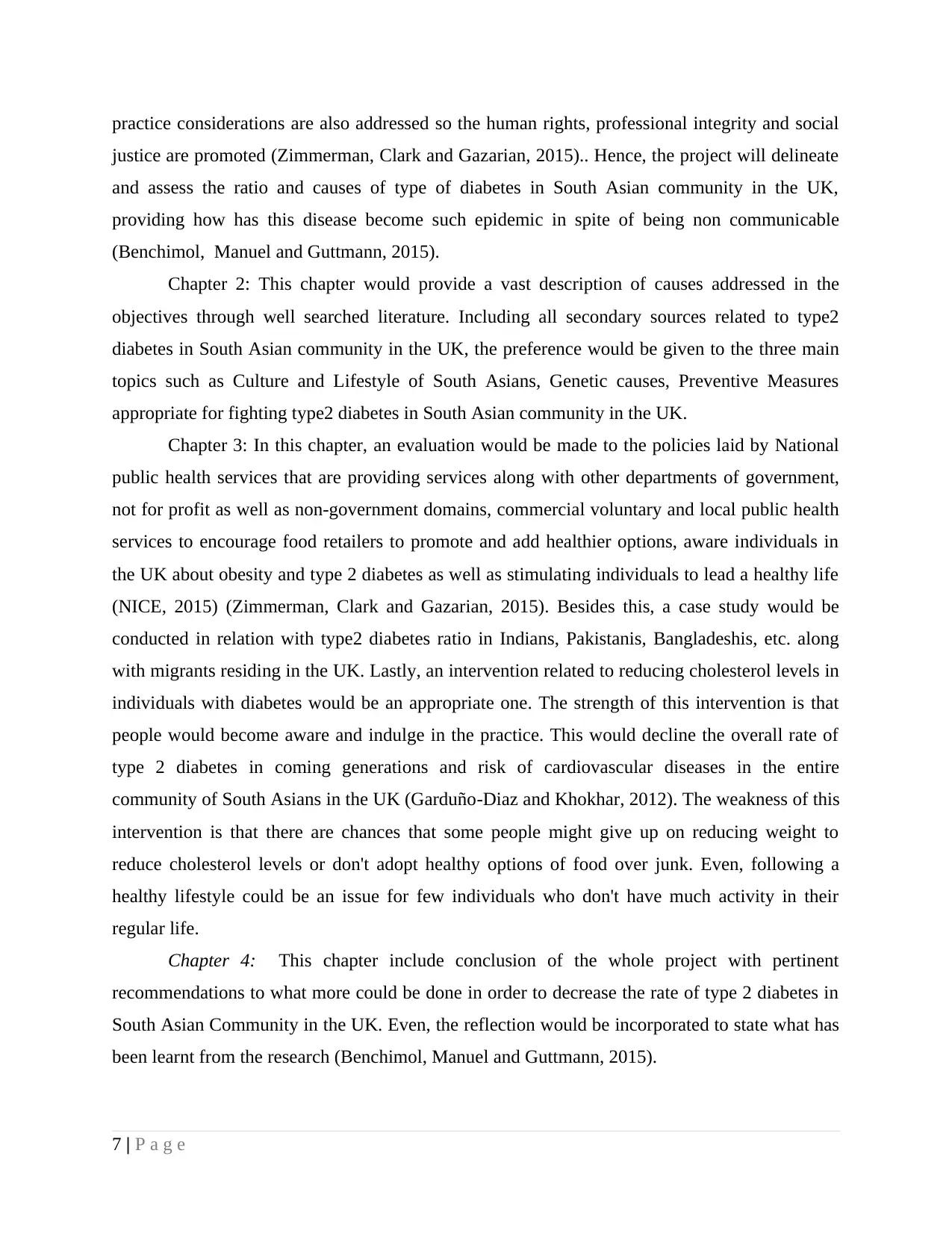
practice considerations are also addressed so the human rights, professional integrity and social
justice are promoted (Zimmerman, Clark and Gazarian, 2015).. Hence, the project will delineate
and assess the ratio and causes of type of diabetes in South Asian community in the UK,
providing how has this disease become such epidemic in spite of being non communicable
(Benchimol, Manuel and Guttmann, 2015).
Chapter 2: This chapter would provide a vast description of causes addressed in the
objectives through well searched literature. Including all secondary sources related to type2
diabetes in South Asian community in the UK, the preference would be given to the three main
topics such as Culture and Lifestyle of South Asians, Genetic causes, Preventive Measures
appropriate for fighting type2 diabetes in South Asian community in the UK.
Chapter 3: In this chapter, an evaluation would be made to the policies laid by National
public health services that are providing services along with other departments of government,
not for profit as well as non-government domains, commercial voluntary and local public health
services to encourage food retailers to promote and add healthier options, aware individuals in
the UK about obesity and type 2 diabetes as well as stimulating individuals to lead a healthy life
(NICE, 2015) (Zimmerman, Clark and Gazarian, 2015). Besides this, a case study would be
conducted in relation with type2 diabetes ratio in Indians, Pakistanis, Bangladeshis, etc. along
with migrants residing in the UK. Lastly, an intervention related to reducing cholesterol levels in
individuals with diabetes would be an appropriate one. The strength of this intervention is that
people would become aware and indulge in the practice. This would decline the overall rate of
type 2 diabetes in coming generations and risk of cardiovascular diseases in the entire
community of South Asians in the UK (Garduño‐Diaz and Khokhar, 2012). The weakness of this
intervention is that there are chances that some people might give up on reducing weight to
reduce cholesterol levels or don't adopt healthy options of food over junk. Even, following a
healthy lifestyle could be an issue for few individuals who don't have much activity in their
regular life.
Chapter 4: This chapter include conclusion of the whole project with pertinent
recommendations to what more could be done in order to decrease the rate of type 2 diabetes in
South Asian Community in the UK. Even, the reflection would be incorporated to state what has
been learnt from the research (Benchimol, Manuel and Guttmann, 2015).
7 | P a g e
justice are promoted (Zimmerman, Clark and Gazarian, 2015).. Hence, the project will delineate
and assess the ratio and causes of type of diabetes in South Asian community in the UK,
providing how has this disease become such epidemic in spite of being non communicable
(Benchimol, Manuel and Guttmann, 2015).
Chapter 2: This chapter would provide a vast description of causes addressed in the
objectives through well searched literature. Including all secondary sources related to type2
diabetes in South Asian community in the UK, the preference would be given to the three main
topics such as Culture and Lifestyle of South Asians, Genetic causes, Preventive Measures
appropriate for fighting type2 diabetes in South Asian community in the UK.
Chapter 3: In this chapter, an evaluation would be made to the policies laid by National
public health services that are providing services along with other departments of government,
not for profit as well as non-government domains, commercial voluntary and local public health
services to encourage food retailers to promote and add healthier options, aware individuals in
the UK about obesity and type 2 diabetes as well as stimulating individuals to lead a healthy life
(NICE, 2015) (Zimmerman, Clark and Gazarian, 2015). Besides this, a case study would be
conducted in relation with type2 diabetes ratio in Indians, Pakistanis, Bangladeshis, etc. along
with migrants residing in the UK. Lastly, an intervention related to reducing cholesterol levels in
individuals with diabetes would be an appropriate one. The strength of this intervention is that
people would become aware and indulge in the practice. This would decline the overall rate of
type 2 diabetes in coming generations and risk of cardiovascular diseases in the entire
community of South Asians in the UK (Garduño‐Diaz and Khokhar, 2012). The weakness of this
intervention is that there are chances that some people might give up on reducing weight to
reduce cholesterol levels or don't adopt healthy options of food over junk. Even, following a
healthy lifestyle could be an issue for few individuals who don't have much activity in their
regular life.
Chapter 4: This chapter include conclusion of the whole project with pertinent
recommendations to what more could be done in order to decrease the rate of type 2 diabetes in
South Asian Community in the UK. Even, the reflection would be incorporated to state what has
been learnt from the research (Benchimol, Manuel and Guttmann, 2015).
7 | P a g e
Paraphrase This Document
Need a fresh take? Get an instant paraphrase of this document with our AI Paraphraser
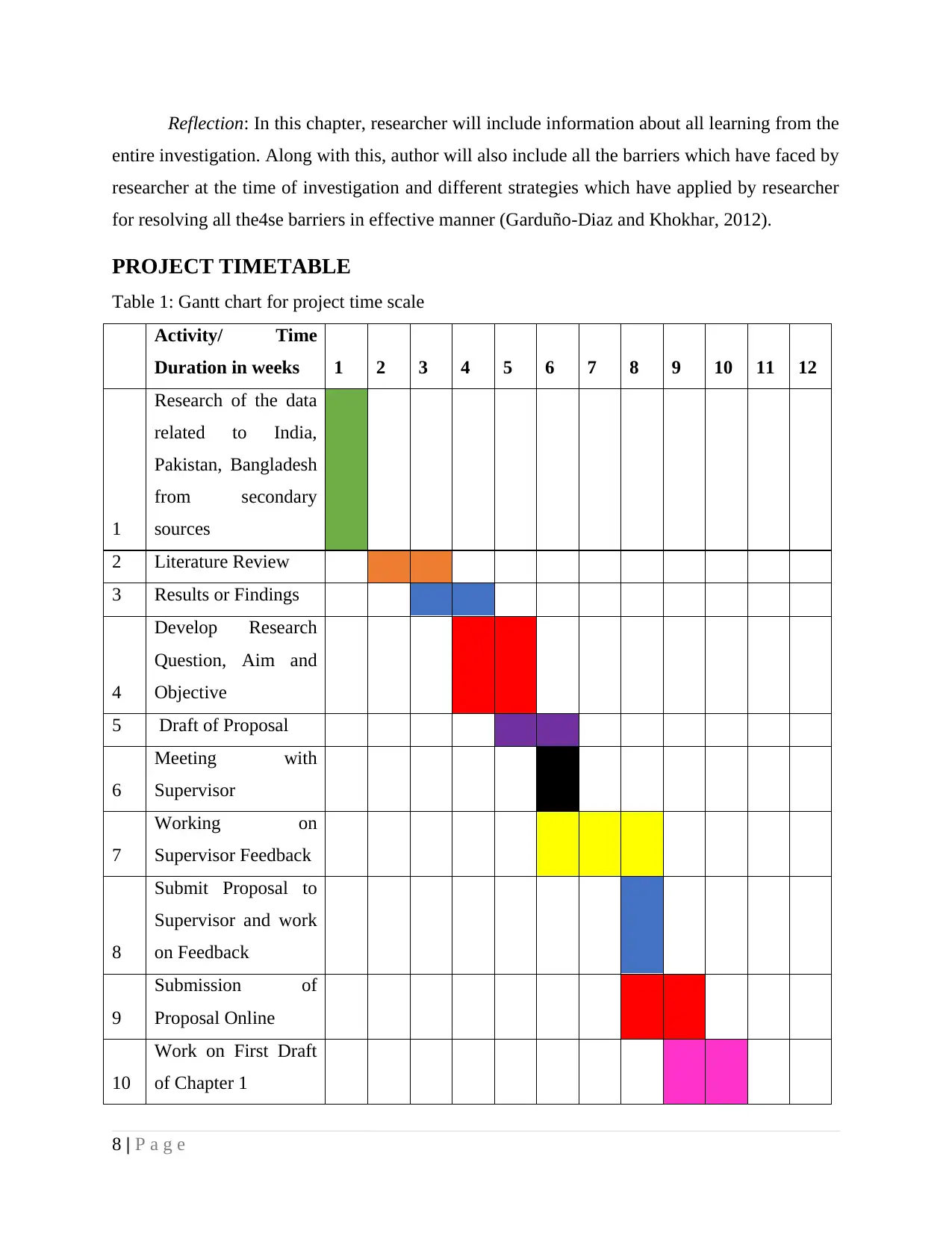
Reflection: In this chapter, researcher will include information about all learning from the
entire investigation. Along with this, author will also include all the barriers which have faced by
researcher at the time of investigation and different strategies which have applied by researcher
for resolving all the4se barriers in effective manner (Garduño‐Diaz and Khokhar, 2012).
PROJECT TIMETABLE
Table 1: Gantt chart for project time scale
Activity/ Time
Duration in weeks 1 2 3 4 5 6 7 8 9 10 11 12
1
Research of the data
related to India,
Pakistan, Bangladesh
from secondary
sources
2 Literature Review
3 Results or Findings
4
Develop Research
Question, Aim and
Objective
5 Draft of Proposal
6
Meeting with
Supervisor
7
Working on
Supervisor Feedback
8
Submit Proposal to
Supervisor and work
on Feedback
9
Submission of
Proposal Online
10
Work on First Draft
of Chapter 1
8 | P a g e
entire investigation. Along with this, author will also include all the barriers which have faced by
researcher at the time of investigation and different strategies which have applied by researcher
for resolving all the4se barriers in effective manner (Garduño‐Diaz and Khokhar, 2012).
PROJECT TIMETABLE
Table 1: Gantt chart for project time scale
Activity/ Time
Duration in weeks 1 2 3 4 5 6 7 8 9 10 11 12
1
Research of the data
related to India,
Pakistan, Bangladesh
from secondary
sources
2 Literature Review
3 Results or Findings
4
Develop Research
Question, Aim and
Objective
5 Draft of Proposal
6
Meeting with
Supervisor
7
Working on
Supervisor Feedback
8
Submit Proposal to
Supervisor and work
on Feedback
9
Submission of
Proposal Online
10
Work on First Draft
of Chapter 1
8 | P a g e
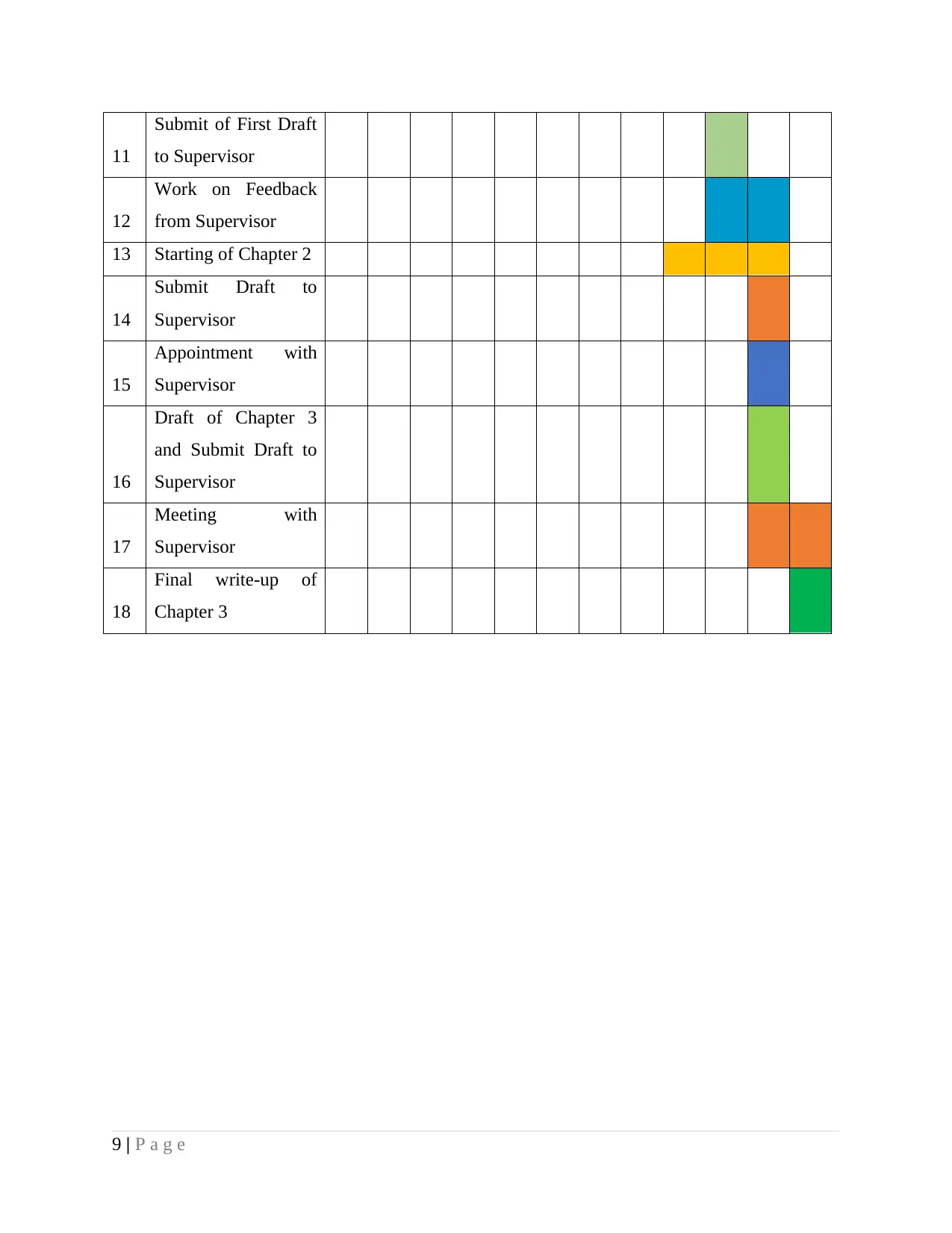
11
Submit of First Draft
to Supervisor
12
Work on Feedback
from Supervisor
13 Starting of Chapter 2
14
Submit Draft to
Supervisor
15
Appointment with
Supervisor
16
Draft of Chapter 3
and Submit Draft to
Supervisor
17
Meeting with
Supervisor
18
Final write-up of
Chapter 3
9 | P a g e
Submit of First Draft
to Supervisor
12
Work on Feedback
from Supervisor
13 Starting of Chapter 2
14
Submit Draft to
Supervisor
15
Appointment with
Supervisor
16
Draft of Chapter 3
and Submit Draft to
Supervisor
17
Meeting with
Supervisor
18
Final write-up of
Chapter 3
9 | P a g e
⊘ This is a preview!⊘
Do you want full access?
Subscribe today to unlock all pages.

Trusted by 1+ million students worldwide
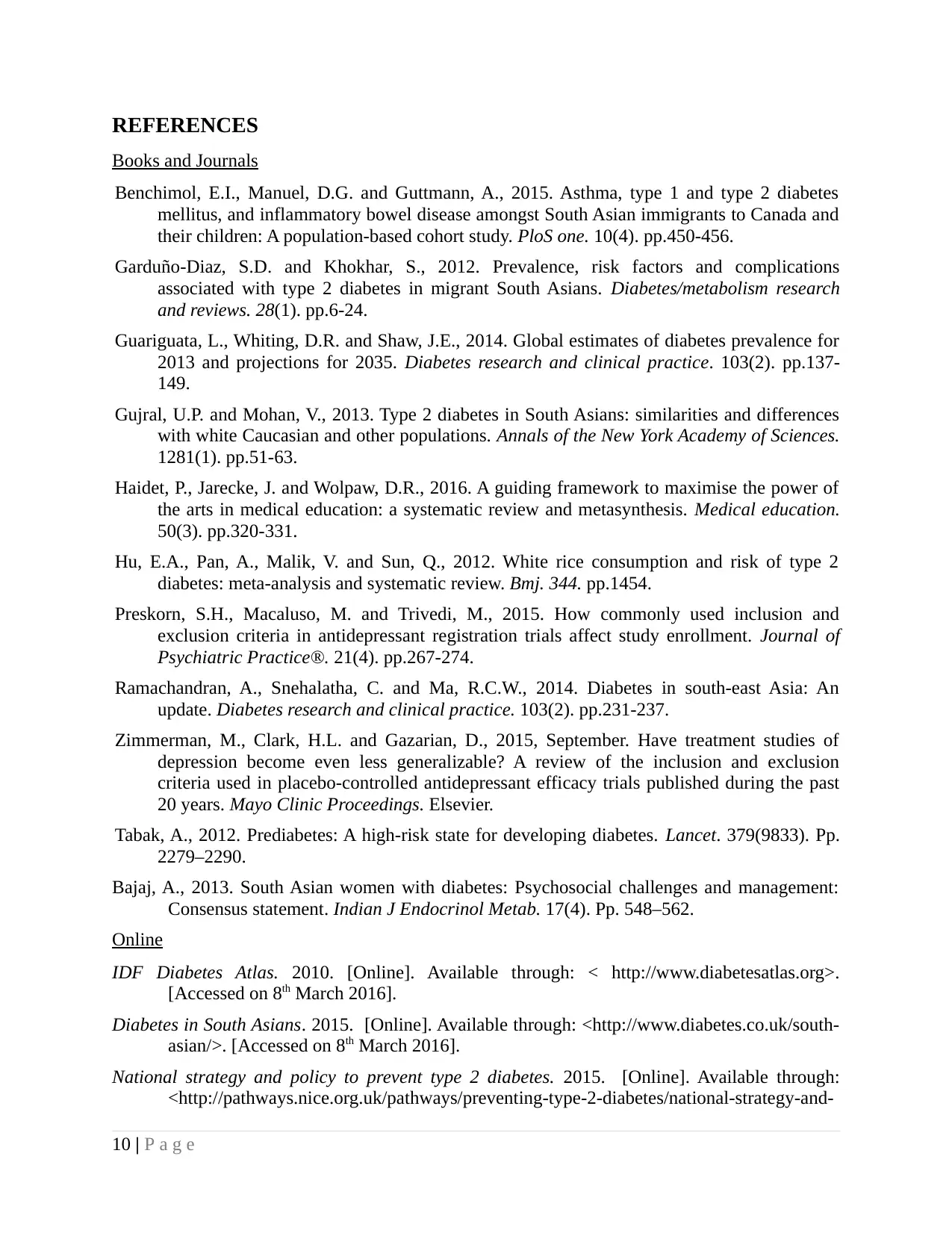
REFERENCES
Books and Journals
Benchimol, E.I., Manuel, D.G. and Guttmann, A., 2015. Asthma, type 1 and type 2 diabetes
mellitus, and inflammatory bowel disease amongst South Asian immigrants to Canada and
their children: A population-based cohort study. PloS one. 10(4). pp.450-456.
Garduño‐Diaz, S.D. and Khokhar, S., 2012. Prevalence, risk factors and complications
associated with type 2 diabetes in migrant South Asians. Diabetes/metabolism research
and reviews. 28(1). pp.6-24.
Guariguata, L., Whiting, D.R. and Shaw, J.E., 2014. Global estimates of diabetes prevalence for
2013 and projections for 2035. Diabetes research and clinical practice. 103(2). pp.137-
149.
Gujral, U.P. and Mohan, V., 2013. Type 2 diabetes in South Asians: similarities and differences
with white Caucasian and other populations. Annals of the New York Academy of Sciences.
1281(1). pp.51-63.
Haidet, P., Jarecke, J. and Wolpaw, D.R., 2016. A guiding framework to maximise the power of
the arts in medical education: a systematic review and metasynthesis. Medical education.
50(3). pp.320-331.
Hu, E.A., Pan, A., Malik, V. and Sun, Q., 2012. White rice consumption and risk of type 2
diabetes: meta-analysis and systematic review. Bmj. 344. pp.1454.
Preskorn, S.H., Macaluso, M. and Trivedi, M., 2015. How commonly used inclusion and
exclusion criteria in antidepressant registration trials affect study enrollment. Journal of
Psychiatric Practice®. 21(4). pp.267-274.
Ramachandran, A., Snehalatha, C. and Ma, R.C.W., 2014. Diabetes in south-east Asia: An
update. Diabetes research and clinical practice. 103(2). pp.231-237.
Zimmerman, M., Clark, H.L. and Gazarian, D., 2015, September. Have treatment studies of
depression become even less generalizable? A review of the inclusion and exclusion
criteria used in placebo-controlled antidepressant efficacy trials published during the past
20 years. Mayo Clinic Proceedings. Elsevier.
Tabak, A., 2012. Prediabetes: A high-risk state for developing diabetes. Lancet. 379(9833). Pp.
2279–2290.
Bajaj, A., 2013. South Asian women with diabetes: Psychosocial challenges and management:
Consensus statement. Indian J Endocrinol Metab. 17(4). Pp. 548–562.
Online
IDF Diabetes Atlas. 2010. [Online]. Available through: < http://www.diabetesatlas.org>.
[Accessed on 8th March 2016].
Diabetes in South Asians. 2015. [Online]. Available through: <http://www.diabetes.co.uk/south-
asian/>. [Accessed on 8th March 2016].
National strategy and policy to prevent type 2 diabetes. 2015. [Online]. Available through:
<http://pathways.nice.org.uk/pathways/preventing-type-2-diabetes/national-strategy-and-
10 | P a g e
Books and Journals
Benchimol, E.I., Manuel, D.G. and Guttmann, A., 2015. Asthma, type 1 and type 2 diabetes
mellitus, and inflammatory bowel disease amongst South Asian immigrants to Canada and
their children: A population-based cohort study. PloS one. 10(4). pp.450-456.
Garduño‐Diaz, S.D. and Khokhar, S., 2012. Prevalence, risk factors and complications
associated with type 2 diabetes in migrant South Asians. Diabetes/metabolism research
and reviews. 28(1). pp.6-24.
Guariguata, L., Whiting, D.R. and Shaw, J.E., 2014. Global estimates of diabetes prevalence for
2013 and projections for 2035. Diabetes research and clinical practice. 103(2). pp.137-
149.
Gujral, U.P. and Mohan, V., 2013. Type 2 diabetes in South Asians: similarities and differences
with white Caucasian and other populations. Annals of the New York Academy of Sciences.
1281(1). pp.51-63.
Haidet, P., Jarecke, J. and Wolpaw, D.R., 2016. A guiding framework to maximise the power of
the arts in medical education: a systematic review and metasynthesis. Medical education.
50(3). pp.320-331.
Hu, E.A., Pan, A., Malik, V. and Sun, Q., 2012. White rice consumption and risk of type 2
diabetes: meta-analysis and systematic review. Bmj. 344. pp.1454.
Preskorn, S.H., Macaluso, M. and Trivedi, M., 2015. How commonly used inclusion and
exclusion criteria in antidepressant registration trials affect study enrollment. Journal of
Psychiatric Practice®. 21(4). pp.267-274.
Ramachandran, A., Snehalatha, C. and Ma, R.C.W., 2014. Diabetes in south-east Asia: An
update. Diabetes research and clinical practice. 103(2). pp.231-237.
Zimmerman, M., Clark, H.L. and Gazarian, D., 2015, September. Have treatment studies of
depression become even less generalizable? A review of the inclusion and exclusion
criteria used in placebo-controlled antidepressant efficacy trials published during the past
20 years. Mayo Clinic Proceedings. Elsevier.
Tabak, A., 2012. Prediabetes: A high-risk state for developing diabetes. Lancet. 379(9833). Pp.
2279–2290.
Bajaj, A., 2013. South Asian women with diabetes: Psychosocial challenges and management:
Consensus statement. Indian J Endocrinol Metab. 17(4). Pp. 548–562.
Online
IDF Diabetes Atlas. 2010. [Online]. Available through: < http://www.diabetesatlas.org>.
[Accessed on 8th March 2016].
Diabetes in South Asians. 2015. [Online]. Available through: <http://www.diabetes.co.uk/south-
asian/>. [Accessed on 8th March 2016].
National strategy and policy to prevent type 2 diabetes. 2015. [Online]. Available through:
<http://pathways.nice.org.uk/pathways/preventing-type-2-diabetes/national-strategy-and-
10 | P a g e
Paraphrase This Document
Need a fresh take? Get an instant paraphrase of this document with our AI Paraphraser
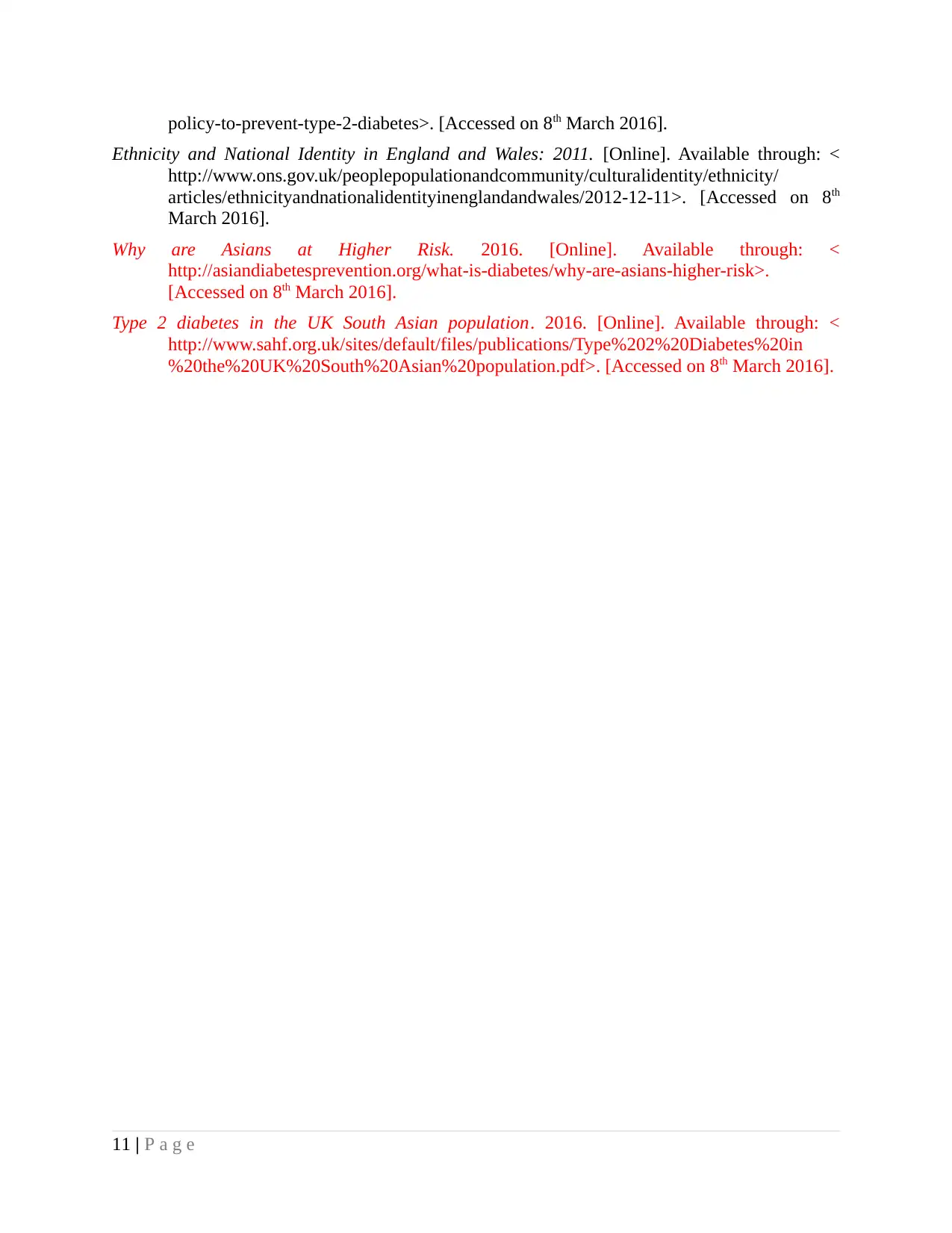
policy-to-prevent-type-2-diabetes>. [Accessed on 8th March 2016].
Ethnicity and National Identity in England and Wales: 2011. [Online]. Available through: <
http://www.ons.gov.uk/peoplepopulationandcommunity/culturalidentity/ethnicity/
articles/ethnicityandnationalidentityinenglandandwales/2012-12-11>. [Accessed on 8th
March 2016].
Why are Asians at Higher Risk. 2016. [Online]. Available through: <
http://asiandiabetesprevention.org/what-is-diabetes/why-are-asians-higher-risk>.
[Accessed on 8th March 2016].
Type 2 diabetes in the UK South Asian population. 2016. [Online]. Available through: <
http://www.sahf.org.uk/sites/default/files/publications/Type%202%20Diabetes%20in
%20the%20UK%20South%20Asian%20population.pdf>. [Accessed on 8th March 2016].
11 | P a g e
Ethnicity and National Identity in England and Wales: 2011. [Online]. Available through: <
http://www.ons.gov.uk/peoplepopulationandcommunity/culturalidentity/ethnicity/
articles/ethnicityandnationalidentityinenglandandwales/2012-12-11>. [Accessed on 8th
March 2016].
Why are Asians at Higher Risk. 2016. [Online]. Available through: <
http://asiandiabetesprevention.org/what-is-diabetes/why-are-asians-higher-risk>.
[Accessed on 8th March 2016].
Type 2 diabetes in the UK South Asian population. 2016. [Online]. Available through: <
http://www.sahf.org.uk/sites/default/files/publications/Type%202%20Diabetes%20in
%20the%20UK%20South%20Asian%20population.pdf>. [Accessed on 8th March 2016].
11 | P a g e
1 out of 11
Related Documents
Your All-in-One AI-Powered Toolkit for Academic Success.
+13062052269
info@desklib.com
Available 24*7 on WhatsApp / Email
![[object Object]](/_next/static/media/star-bottom.7253800d.svg)
Unlock your academic potential
Copyright © 2020–2025 A2Z Services. All Rights Reserved. Developed and managed by ZUCOL.





